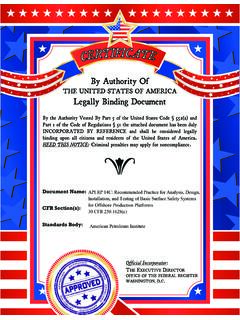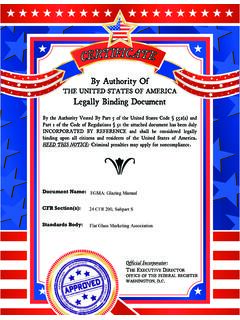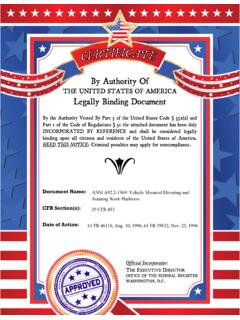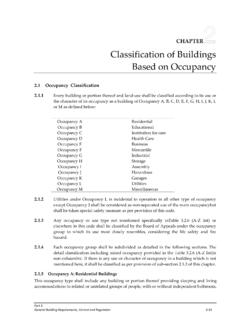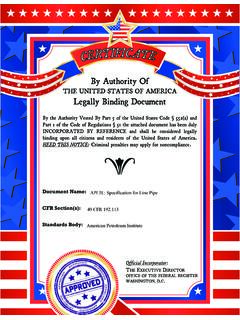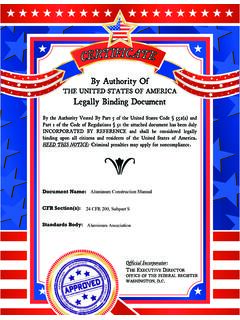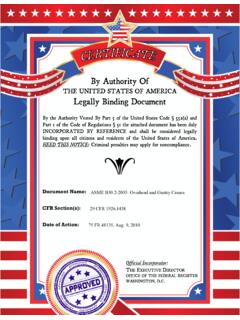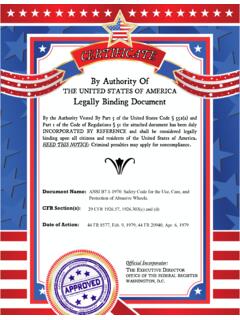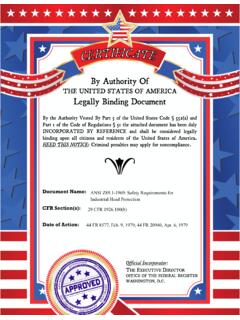Transcription of IS 8237 (1985): Code of Practice for Protection of Slope ...
1 Disclosure to Promote the Right To InformationWhereas the Parliament of India has set out to provide a practical regime of right to information for citizens to secure access to information under the control of public authorities, in order to promote transparency and accountability in the working of every public authority, and whereas the attached publication of the Bureau of Indian Standards is of particular interest to the public, particularly disadvantaged communities and those engaged in the pursuit of education and knowledge, the attached public safety standard is made available to promote the timely dissemination of this information in an accurate manner to the public. ! $ ' + - Satyanarayan Gangaram Pitroda Invent a New India Using Knowledge 0 1 ' 5 Jawaharlal Nehru Step Out From the Old to the New 1 + , 1 + Mazdoor Kisan Shakti Sangathan The Right to Information, The Right to Live ! > 0 B Bhart hari N ti atakam Knowledge is such a treasure which cannot be stolen Invent a New India Using Knowledge IS 8237 (1985): Code of Practice for Protection of Slopefor Reservoir Embankments [WRD 10: Reservoirs and Lakes] IS : 8237 - 1985 Indian Standard CODE OF Practice FOR Protection OF Slope FOR RESERVOIR EMBANKMENT ( First Reoision ) Dams ( Overflow and Non-overflow ) Sectional Committee, BDC 53 Chairman SHRI V.
2 B. PATEL Representing Irrigation Department, Government of Gujarat, Gandhinagar Members SHRI R. K. BHASIN Bhakra Beas Management Board, Nangal Township SHRI J. S. KHURANA ( Alternate ) SHRI H. S. BHAT In personal capacity (No. 599, 10th Cross, Jayanagar, -Bangalore) SHRI M. V. BRAHME Tata Consulting Engineers, Bangalore SHRI R. SIVASANKAR ( Alternate ) SHRI B. K. CHADHA Consulting Engineering Services (India) Private Ltd, New Delhi PROF HARI KRISHNA ( Alternate ) PROF M. C. CHATURVEDI Indian Institute of Technology, New Delhi CHIEF ENGINEER, THEIN DAM Irrigation Department, Government of Punjab, DESIGN Chandigarh DIRECTOR ( DAM ), THEIN DAM DESIGN ( Alternate ) SHRI C. ETTY DARWIN In personal capacity ( P. 0. Muttada. Trivandrum ) SHRI B. DASS Irrigation and Waterways Department, Government of West Bengal, Calcutta DIRECTOR Central Water and Power Research Station, Pune SHRI S. L. MOKHASHI ( Alternate ) DIRECTOR ( E & RDD-I ) Central Water Commission, New Delhi DEPUTY DIRECTOR (E & RDD-I ) ( Alternate ) DIRECTOR, INSTITUTE OF HYDRAU- Public Works Department, Government of Tamil LICS & HYDROLOGY, POONDI Nadu, Madras SUPERINTENDING ENGINEER ( DESIGNS ) ( Alternate ) ( Continued on page 2 ) I@ Copyright 1986 INDIAN STANDARDS INSTITUTION This publication is protected under the Indian Copyright Act ( XIV of 1957 ) and reproduction in whole or in part by any means except with written permission of the publisher shall be deemed to be an infringement of copyright under the said Act.
3 IS : 8237 - 1985 ( Continued from page 1 ) Members Representing SHR~ M. V. S. 1vaNoA~ Hindustan Construction Company Ltd, Bombay SHRI K. MADHAVAN Central Water Commission, New Delhi DIRECTOR (~C & MDD-I) ( AIternare ) SHRI S. P. MATHUR Major, Medium & Minor Irrigation Department, Government of Madhya Pradesh, Bhopal SHRI A. M. NAYAK ( Alternate ) SHRI RAMABHADRAN NAIR Kerala State Electricity Board, Trivandrum SPECIAL DUTY, Irrigation Department, Government of Andhra APERL Pradesh, Hyderabad SUPERINTENDING ENGINEER ( DAMS ) ( CD0 ) ( Alternate ) SHRI RAM IQBAL SINGH Irrigation Department, Government of Uttar Pradesh, Lucknow SHRI BISHAM LAL JATANA ( Alternate ) SHRI T. RANGANNA Karnataka Power Corporation Ltd, Bangalore REP~ESE~ATIVE Institution of Engineers ( India ), Calcutta SECRETARY Central Board of Irrigation and Power, New Delhi DIRECTOR ( CIVIL ) (Alternate ) SUPERINTENDING ENGXNEER(CDO) Irrigation Department, Government of Gujarat, Gandhinagar UNIT LEADER ( C ) ( Alternnte ) SUPERINTENDING ENGINEER (MD), Irrigation Department, Government of Maharashtra, CD0 Bombay SHRI G.
4 RAMAN, Director General, ISI ( Ex-officio Member ) Director ( Civ Engg ) Secretary SHRI K. K. SHARMA Joint Director ( Civ Engg ), ISI Earth and Rockfill Dams Subcommittee, BDC 53 : 2 Convener SHRI M. U. PUROHIT Irrigation Department, Government of Gujarat, Gandhinagar * Members UNIT LEADER ( B ) ( Alternate to Shri M. U. Purohit ) SHRI N. K. AROR~ Bhakra Beas Management Board, Nangal Township SHRI K. K. S. BHANDARI ( Alternate ) PKOF M. C. CHATURVEDI Indian Institute of Technology, New Delhi SHRI R. P. CHOPRA National Projects Construction Corporation Ltd, New Delhi SHRI K. N. TANEJA ( Alternate ) ( Continued on page 13 ) 2 IS : 8237 - 1985 Indian Standard CODE OF Practice FOR Protection OF Slope FOR RESERVOIR EMBANKMENT ( First RetCon ) 0. FOREWORD This Indian Standard (First Revision) was adopted by the Indian Standards Institution on 20 November 1985, after the draft finalized by the Dams ( Overflow and Non-overflow ) Sectional Committee had been approved by the Civil Engineering Division Council.
5 Embankment slopes need to be protected against wave action, rain wash, wind action, velocity of flow or over-topping of embankments by reservoir water. Protection against erosion due to over-topping is provided by ensuring sufficient free board and spillway capacity and also by providing erosion resistant surface at top, turfing to the downstream Slope , etc. Protection against erosion due to wave action, rain wash, wind action or velocity of flow can be provided in many ways such as cement concrete surface, flexible brick pitching, and riprap on the upstream Slope and pitching or turfing on the downstream Slope . Riprap is not common in use in India and as such that only is covered in this code. This standard was first published in 1976. Since than more dams have been built and more experience has been gained and to reflect these the present revision has been taken up. Important changes made in the standard include: a) Extent of riprap has been defined with respect to minimum draw- down level ( MDDL ) instead of low water level ( LWL ).
6 B) Filter has been recommended to be provided in two layers. c) Criteria for fixing minimum weight of stones with respect to significant wave height has been replaced by relating quarried thickness of riprap to wave height. 3 c IS : 8237 - 1985 1. SCOPE This code covers design of Protection of Slope for reservoir embank- ments by riprap. Reference has been made to turfing and drainage arrangements for the downstream Slope . This code does not cover Protection against damage due to velocity of flow for which additional pitching ( or other measures) may be required. 2. TERMLNOLOGY For the purpose of this code, the following definitions shall apply. Minimum Draw Down Level ( MDDL ) -It is the level below which the reservoir will not be drawn down so as to maintain a minimum head required in power projects. Riprap -It is the Protection to the embankment material against erosion due to wave action, velocity of flow, rain wash, wind action, etc, provided by placing a Protection layer of rock fragments or manufactured material.
7 Riprap may be placed on Slope either by hand or it may be simply dumped. Hand Placed Rijwap -It consists of natural stones quarried laid flat or laid with projections boulders or specially manufactured material like cement concrete blocks and soil-cement blocks, carefully placed by hand in a more or less definite pattern with a minimum amount of voids its top surface reasonably uniform and free of loose stones or alternately panelwise concrete slabs or precast concrete interlocking type blocks. Dumped Riprap - It consists of boulders or blasted rock reasonably free from quarry fines and dumped in place by mechanical means. Wave Action - It consists essentially of the dynamic impact effect of the waves as they impinge on the Slope and suction forces set up on the embankment face as the waves ride up and down. Wave Height - The height of wave is reckoned as measured from the trough to the crest of the wave. For determination of wave-height, refer to IS : 10635-1983*.
8 Wave Run-up - It is the difference (vertical height) between maximum elevation attained by wave run-up on a Slope and the water elevation on the Slope excluding wave action. Turfing - It is a cover of grass grown over an area to prevent erosion of soil particles by rain wash. *Guidelines-for freeboard requirement in embankment dams. 4 c IS : 8237 - 1985 3. GENERAL Considerations for Adoption The choice of type of riprap is governed mainly from the considera- tion of availability of suitable materials within reasonable distance and cost of placement. Overall economics for riprap requires consideration of the fact that the wave run-up height on a Slope with hand placed riprap for the same wave -height and embankment Slope , is about to l-5 times more than that for dumped riprap due to smoother surface in case of the former and also systematic placement and better workmanship in general. Extent of Riprap - Riprap should be provided from an elevation m or half of maximum wave height at MDDL whichever is more below minimum drawdown level ( MDDL) to the top of the dam.
9 At sites where there is possibility of flow parallel to the embankment below the lowest water level and exigencies of drawing below MDDL, riprap may be extended further below the MDDL as required. Riprap should preferably be terminated at the lower end in a berm provided in the embankment ( see Fig. 1 ). FIG. 1 PITCHING WITH BERM BELOW MDDL Where a berm is not provided, the riprap should be terminated duly keyed to a toe support ( see Fig. 2 ). Similar toe support arrangement for .riprap extending to ground level is shown in Fig. 3. The arrangement for riprap terminating at rock surface is shown in Fig. 4. Site Preparation - Allowance shall be made in the constructed embank- ment to enable dressing of the outer Slope to get compacted surface for laying filter layer(s) and then placing of the riprap over a compacted surface. 5 FIG. 2 PITCHING WITH NO BERM BELOW MDDL FIG. 3 PITCHING TERMINATING AT ROCK SURFACE FIG. 4 PITCHING AT STRIPPED GROUND LEVEL 4. REQUIREMENTS FOR ROCK USED AS RIPRAP Stone for riprap shall be hard and durable and shall not crumble on long exposure to water, frost and air.
10 C 6 IS : 8237 - 1985 5. FILTER Provision of two layers of filter ( coarse and fine ) are usually necessary under riprap to prevent the waves from eroding and washing out the underlying embankment material. Also since the riprap is generally poorly graded due to predominance of one size material, the provision of adequate filter is essential. The thickness and number of layers of filter are mainly governed by considerations of intensity of wave action gradation of riprap, gradation of embankment material and ease of construction. Thickness of each of the two layers shall not be less than 150 mm under hand placed riprap and 200 mm under dumped riprap. Gradation requirement for the coarse filter material with respect to riprap material should conform to the criteria that D,, size of the coarse filter material shall not be less than l/10 of D,, size of the riprap material. The gradation requirements for the fine filter with respect to embankment material should conform to the criteria that D,, size of the fine filter material shall not exceed 5 times the D,, size of the retained embankment material.
